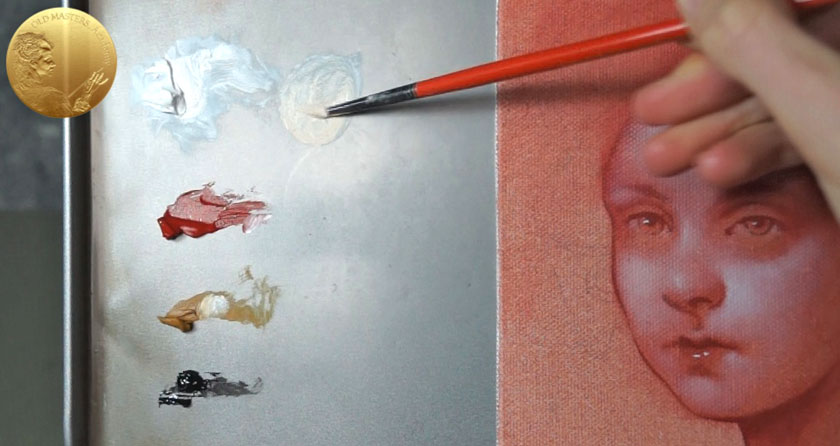Art Lesson 30, Part 6
In this lesson, you will discover a Direct Painting Method
Learn how to paint like the Old Masters!
Old Masters Academy Online Course
Self-study, self-paced online video courseLifetime membershipOne-time payment: $487Enroll Now!Personal Tutoring online + Online Course
Unlimited tutoring by the Academy teachersLifetime membershipOne-time payment: $997Enroll Now!« Back to the Art Lessons List
Direct Painting Method
We continue our multi-layered painting. The monochrome layer is dry. Now, we have to proceed with painting in Colors. As usual in these exercises, we use the Titian Palette: White Titanium, Venetian Red, Yellow Ocher and Mars Black. What we should do now is make a quick Alla Prima sketch, with the idea of following the completion of the painting with Glazes. That’s why this Alla Prima Underglazing should be lighter and colder in Color, than the end result after we glaze it over. We will do everything quickly – it will be just one session of Underglazing.
First of all, we mix a skin color by adding Yellow to White. We indicate the whitest places of the face – the forehead and cheeks – by thickly spreading the paint.

Now, we leave the skin color for a while and mix Red and Black for the hair and shaded areas. We apply the mix in different amounts of thickness, with thick brushstrokes indicating hair style and spreading the paint thinly in shaded areas of the face.
We carry on with the spreading of the skin color. We vary the volume of the paint. Apply it densely in the most highlighted places, but for the shades, rub the paint into the canvas using the Dry Brush method so that a darker ground applied lower will show through it.
The freshly lined paint for the hair and skin was well blended on the borders of the forehead and hair and in transition from shaded to light.
We paint the irises as usual, by mixing White and Black; we might also add Red to make the mix warmer.
It’s time to place shades in a cold mix of colors. We also set-up the position of the eyebrows in bold strokes.
That’s pretty much it. Now, we just finish with details and smooth the paint in places where the paint made a smooth transition from shaded to light.
The next stage would be finishing the painting in Glazes and Velaturas.




